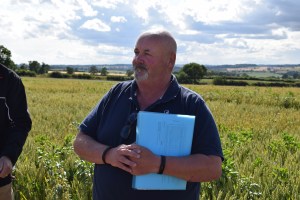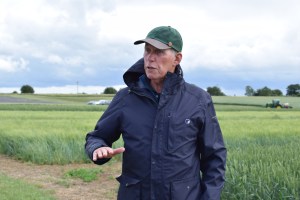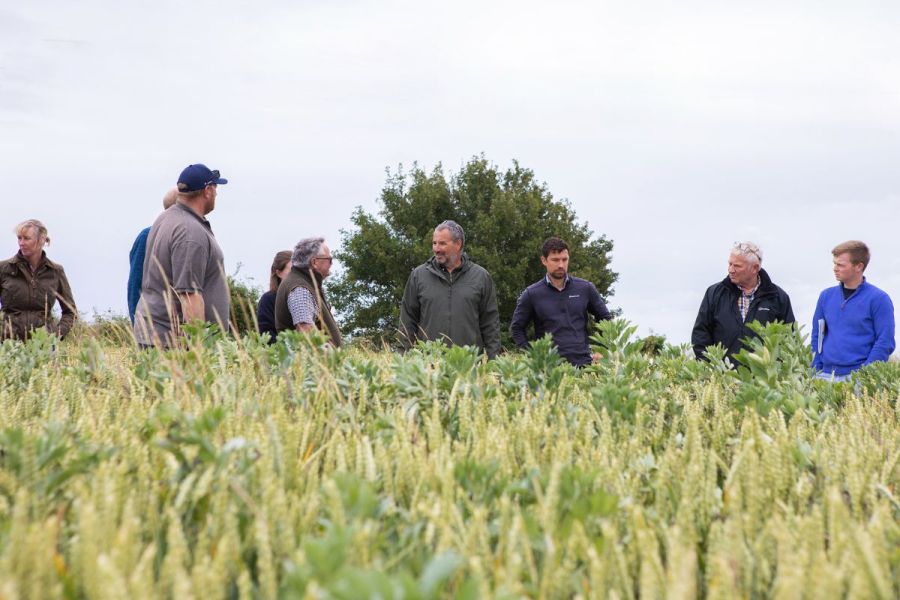Agrovista’s flagship trial site began life investigating innovative blackgrass control measures but later evolved into a full soil health showcase. Luckily, the team never lost sight of that original goal, a tactic proven valuable this season. CPM visits Lamport AgX.
“Year in year out Lamport has shown best practice for blackgrass control centres around minimising soil movement, planting cover crops and utilising spring cropping.”
By Janine Adamson
Now in its tenth year, Lamport AgX continues to attract the crowds, lured by the promise of new findings and perspectives on sustainable farming and soil health. And because it continues to deliver, the site in Northampton remains a valuable resource for knowledge transfer.
However, this season’s extreme grassweed pressure has meant the experts at Lamport have had to return to their roots to provide much required insight on blackgrass management.
Because that’s how the site began – a demonstration of crop rotations and cultivation practices to help with blackgrass control on heavy land. But what it now offers is wider context, even when asked to loop back full circle.

According to Mark Hemmant, not moving soil is the correct thing to do even when faced with dry conditions and an under-performing stale seedbed.
Technical manager, Mark Hemmant, says although the team aims to share something new each year, it’s also about reinforcing the value of solid agronomic practice. “Year in year out Lamport has shown best practice for blackgrass control centres around minimising soil movement, planting cover crops and utilising spring cropping.
“This is then supported by tactical use of best-in-class chemistry. Combining all this together is the way to achieve results, even in a challenging year such as this season. Of course, the added benefit is it’s looking after the soil at the same time,” he says.
To demonstrate, Mark and the team devised a trial to understand the performance of some of the leading herbicide actives when used within a direct drilled scenario at three levels of stubble cultivation – straw-raked, shallow-disced at 3cm and shallow-disced at 8cm.
The work compared Luxinum Plus (cinmethylin) plus PicoMax (pendimethalin+ picolinafen) with Proclus (aclonifen) plus Coliseum (flufenacet+ diflufenican), both with and without Avadex (tri-allate).
“Luxinum is mostly root acting but is also claimed to have activity directly on the seed,” says Mark. “In previous years we found both products to have similar activity on blackgrass, but given the seed claim, we wanted to investigate whether Luxinum would be a better option in a direct drilled scenario where blackgrass seed is left on the surface.”
Rather than a second wheat, which has proven to foster blackgrass populations at Lamport, the previous rotation was a phacelia-based spring cover crop which was then burned off and cultivated in-line with the trial’s protocol.
According to Mark the results were clear, not moving soil is the correct thing to do even when faced with dry conditions and an under-performing stale seedbed. As for comparing chemistry, the results weren’t so clear cut.
“Statistically, the herbicide treatments performed no differently, however visually, it was the Proclus plus Coliseum which came out on top,” he says.
“This could again be down to Proclus’s mode of action, but this time lending itself better to the arid soil due to its persistency. What really stood out is the value of Avadex, which made a statistical difference to blackgrass control across all scenarios.”
He believes because the efficacy of Avadex declines less than other herbicides in droughted environments, the product has shone even more. And whereas in the past Lamport has been all about blackgrass, like many growers, the team’s now experiencing a problem with resistant Italian ryegrass, which Avadex can help to control.
“Using the plough has always been a no-no for us, but to achieve control of ryegrass we’ll have to reintroduce it on a rotational basis. It’s important we don’t provide blanket advice, so in this case, cultural control methods will be even more vital,” he explains.
But what about those looking for something new to talk about? Again, Lamport rose to the occasion. This year, as a result of 2022’s nitrogen crisis, the team challenged themselves to feed a crop of wheat with beans, in other words, successfully bi-crop.
The replicated trial involved sowing at three rates – solo wheat at 350 seeds/m2, wheat plus 20 beans/m2 and wheat plus 40 beans/m2 (the standard rate). To help the wheat to compete, Mark says Avadex and a herbicide programme were used to help control blackgrass.
This was then overlayed with differing nitrogen regimes – untreated, 180kgN/ha, 90kgN/ha, and a combi approach of 130kgN/ha topped up with 30kg of controlled release fertiliser, MZ28. The final variable investigated was destruction timing of the beans – removal at T1, T2 and taken through to harvest.
At the time of CPM’s visit, the crop was still standing with full detailed assessments yet to be made. “From an initial visual perspective, the work clearly shows that if you rely purely on beans to provide wheat nutrition, the crop will yield awfully,” says Mark. “However, the crop treated with 90kgN/ha appears to show a benefit, even when the companion crop is destroyed at the earliest timing.”
According to Mark, this means planting wheat with beans could enable a reduction in nitrogen applications, although he says it’s important to carefully calculate the return on investment. “Bean seed isn’t cheap, so from a basic margin perspective it’s likely to depend on the price of nitrogen at the time, which is highly variable.
“What’s difficult to account for is the impact on the following rotation known as the legacy effect. We plan to monitor this during the next year to see if it’s possible to attribute an agronomic value to companion cropping that’s tangible,” he says.

Niall Atkinson says when companion cropping, beans can’t provide nutritional benefits to oats until root nodulation, when N-fixing takes place.
And although the trial was initially instigated in response to the high price and low availability of inputs, Mark hopes Lamport visitors will find the work useful given the Sustainable Farming Initiative (SFI) now pays for actions such as companion cropping.
Yet this isn’t the first time Agrovista has trialled companion cropping at Lamport – a highlight of 2022 was a crop of winter oats grown alongside winter beans with no inputs bar the seed itself.
The beans were direct drilled on 28 October 2021 at 38 seeds/m2 followed by oats at 340 seeds/m2 on the same day. To compare, a conventional plot of oats received 120kgN/ha plus a robust plant protection programme.
Results-wise, the oats yielded 9.36t/ha with an additional 0.42t/ha of beans – a combined yield of nearly 10t/ha. To push this further, farming systems R&D advisor, Niall Atkinson, says they’re trialling it again this year but this time for a spring crop. “Again, our input costs are only the seed and the glyphosate pre-drilling. So far, the crop looks reasonable and is very clean.
“The objective is to maximise oat production through using beans for added nutrition and notably, to help rooting,” he says. “To that respect, there’s the question of whether in this scenario, there’d be a benefit from using seed-bed nutrition such as DAP. This is because beans can’t provide nutritional benefits to the oats until root nodulation, when the N-fixing takes place,” says Niall.
Given this is off the back of a winter crop, therefore breaking one of Lamport’s golden rules, Mark says he’s interested to see how the approach impacts weed control.
This article was taken from the latest issue of CPM. Read the article in full here.
For more articles like this, subscribe here.
Sign up for Crop Production Magazine’s FREE e-newsletter here.




